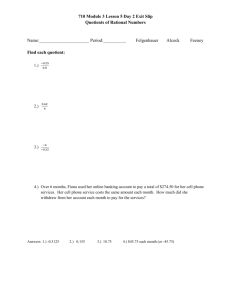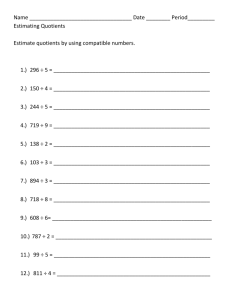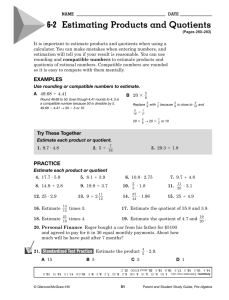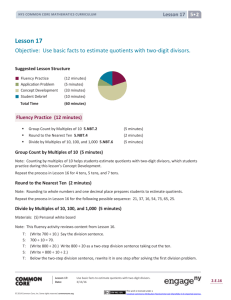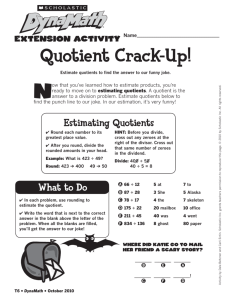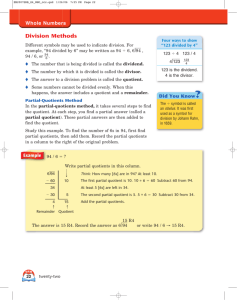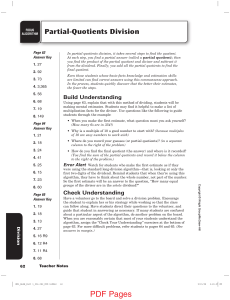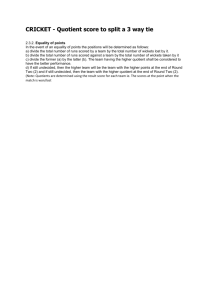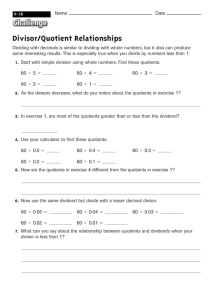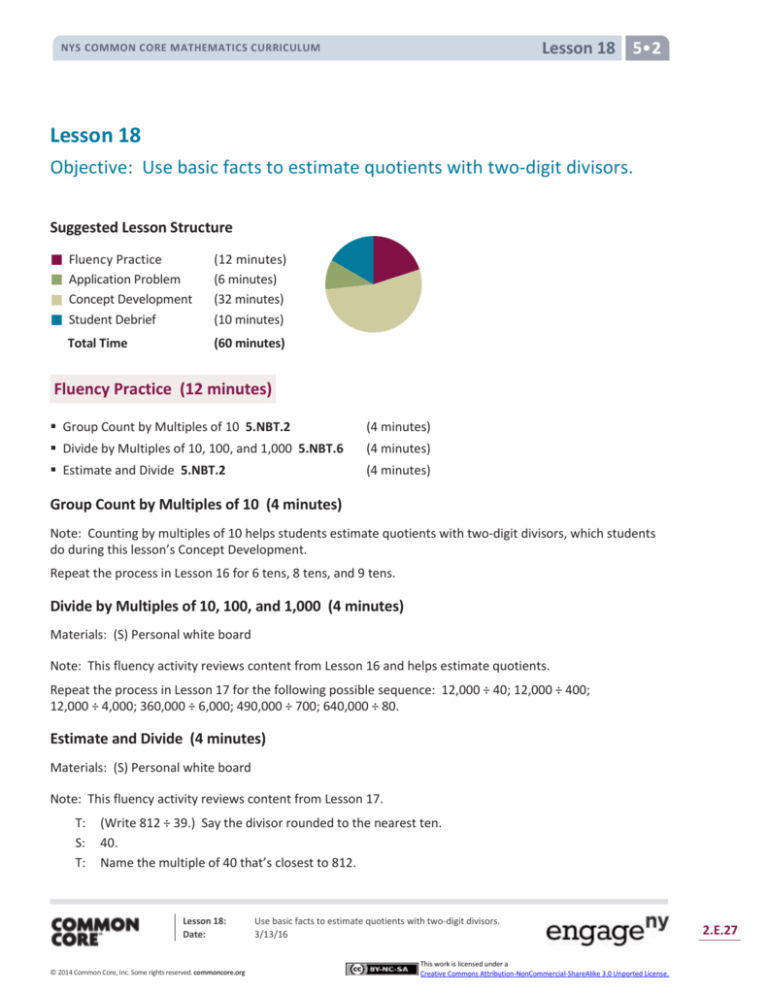
Lesson 18 5
NYS COMMON CORE MATHEMATICS CURRICULUM
Lesson 18
Objective: Use basic facts to estimate quotients with two-digit divisors.
Suggested Lesson Structure
Fluency Practice
Application Problem
Concept Development
Student Debrief
Total Time
(12 minutes)
(6 minutes)
(32 minutes)
(10 minutes)
(60 minutes)
Fluency Practice (12 minutes)
Group Count by Multiples of 10 5.NBT.2
(4 minutes)
Divide by Multiples of 10, 100, and 1,000 5.NBT.6
(4 minutes)
Estimate and Divide 5.NBT.2
(4 minutes)
Group Count by Multiples of 10 (4 minutes)
Note: Counting by multiples of 10 helps students estimate quotients with two-digit divisors, which students
do during this lesson’s Concept Development.
Repeat the process in Lesson 16 for 6 tens, 8 tens, and 9 tens.
Divide by Multiples of 10, 100, and 1,000 (4 minutes)
Materials: (S) Personal white board
Note: This fluency activity reviews content from Lesson 16 and helps estimate quotients.
Repeat the process in Lesson 17 for the following possible sequence: 12,000 ÷ 40; 12,000 ÷ 400;
12,000 ÷ 4,000; 360,000 ÷ 6,000; 490,000 ÷ 700; 640,000 ÷ 80.
Estimate and Divide (4 minutes)
Materials: (S) Personal white board
Note: This fluency activity reviews content from Lesson 17.
T:
S:
T:
(Write 812 ÷ 39.) Say the divisor rounded to the nearest ten.
40.
Name the multiple of 40 that’s closest to 812.
Lesson 18:
Date:
© 2014 Common Core, Inc. Some rights reserved. commoncore.org
Use basic facts to estimate quotients with two-digit divisors.
3/13/16
This work is licensed under a
Creative Commons Attribution-NonCommercial-ShareAlike 3.0 Unported License.
2.E.27
Lesson 18 5
NYS COMMON CORE MATHEMATICS CURRICULUM
S:
T:
S:
T:
S:
800.
On your personal white boards, write a division problem that will estimate the value.
(Write ≈ 800 ÷ 40.)
Below 800 ÷ 40, write the answer.
(Write = 20.)
Repeat the process for the following possible sequence: 183 ÷ 31; 437 ÷ 72; 823 ÷ 97; 8,191 ÷ 92.
Application Problem (6 minutes)
Sandra bought 38 DVD movies for $874. Give an estimate of the cost of each
DVD movie.
Note: This Application Problem is a review of Lesson 17, which focused on
estimation of a three-digit whole by a two-digit divisor. In this lesson, Lesson
18, students estimate the division of a four-digit number by a two-digit
divisor.
Concept Development (32 minutes)
Materials: (S) Personal white board
Problem 1: 8,095 ÷ 23
T:
S:
T:
S:
T:
S:
T:
S:
T:
S:
(Write 8,095 ÷ 23 horizontally on the board.) Which number
should we round first, the whole or divisor? Why?
We round the divisor first so we know what our unit is.
Round the divisor first. This helps us know what multiples to
look for when we are rounding the whole.
Good. What’s 23 rounded to the nearest ten?
20.
Let’s round 8,095 so it is easy to divide by 20. How would we do that? Turn and share with your
partner.
I see that 8 can easily be divided by 2, and 8,000 is easy to divide by 2. So, I can round 8,095 to
8,000. 8 divided by 2 is an easy fact, so I can round 8,095 to 8,000. I can solve 8,000 divided by 2
easily.
Yes. I see an easy fact of 8 divided by 2, so let’s round 8,095 to 8,000. Tell me the expression to
estimate the quotient.
8,000 divided by 20.
(Write ≈ 8,000 ÷ 20.) How can we solve 8,000 divided by 20? Turn and discuss with your partner.
I know that 8,000 divided by 10 equals 800, and 800 divided by 2 equals 400. 8,000 divided by 2
equals 4,000. 4,000 divided by 10 equals 400. 8,000 divided by 20 is the same as 800 divided by
Lesson 18:
Date:
© 2014 Common Core, Inc. Some rights reserved. commoncore.org
Use basic facts to estimate quotients with two-digit divisors.
3/13/16
This work is licensed under a
Creative Commons Attribution-NonCommercial-ShareAlike 3.0 Unported License.
2.E.28
Lesson 18 5
NYS COMMON CORE MATHEMATICS CURRICULUM
T:
S:
T:
S:
T:
S:
2, and the answer is 400.
8,000 divided by 20 is the same as 800 divided by what?
Say the expression.
800 ÷ 2.
(Write = 800 ÷ 2.) Excellent. So what’s the answer?
400.
Say the two division sentences. (Point at the two sentences
on the board as students read aloud.)
8,000 ÷ 20 = 800 ÷ 2 = 400.
Problem 2: 2,691 ÷ 48
T:
T:
S:
T:
T:
S:
T:
S:
T:
S:
T:
T:
MP.2 S:
T:
(Write 2,691 ÷ 48 horizontally on the board.) Take out
NOTES ON
your personal white board. Let’s first round the divisor
MULTIPLE MEANS
48 to the nearest ten.
OF REPRESENTATION:
(Write ≈ ____ ÷ 50 on the board.) Let’s round 2,691 so
it is easy to divide by 50. Remember! You can think of
Unit form is a powerful means of
representing these 4-digit dividends so
multiples of 5 to help you! Turn and talk.
that students can more easily see the
I see an easy fact of 5 times 5 is equal to 25. 26
multiples of the divisor. A model
hundreds is close to 30 hundreds, and that’s easy to
exchange might be:
divide by 5. I can round 2,691 to 3,000. 3,000 is an
T: (Rewrite 2,691 as 26 hundreds + 91
easy multiple of 50. 26 hundreds is close to 25
ones.) Is 26 hundreds a multiple of 5?
hundreds. That’s easy to divide by 5 or 50. I can
Can you think of a multiple of 5 close to
round 2,691 to 2,500, because 2,500 divided by 50 is
26 hundreds?
50.
S: 25 hundreds and 30 hundreds.
I heard both 2,500 and 3,000.
T: Are these also multiples of 50?
Tell your partner how to estimate the quotient using
S: Yes!
3,000 as the rounded whole.
T: Let’s write them in standard form.
3,000 ÷ 50 = 300 ÷ 5 = 60. It’s ten times more than
S: 2,500 and 3,000.
30 ÷ 5. I divided 3,000 by 10 and then divided by 5.
What is 3,000 divided by 50?
60.
I heard another rounded whole, 2,500. How would we estimate the quotient using the rounded
whole of 2,500?
2,500 ÷ 50 = 250 ÷ 5 = 50.
We have two estimated quotients, 60 and 50.
Our estimates are different. What does that mean?
Well, they’re just estimates. Our actual answer would be somewhere around 50 or 60.
Right, one is probably closer to the actual answer than the other. Since they’re both pretty close,
we could use either one if we only want to estimate our answer.
Lesson 18:
Date:
© 2014 Common Core, Inc. Some rights reserved. commoncore.org
Use basic facts to estimate quotients with two-digit divisors.
3/13/16
This work is licensed under a
Creative Commons Attribution-NonCommercial-ShareAlike 3.0 Unported License.
2.E.29
Lesson 18 5
NYS COMMON CORE MATHEMATICS CURRICULUM
Problem 3: 5,484 ÷ 71
T:
T:
S:
T:
S:
T:
S:
(Write 5,484 ÷ 71 horizontally on the board.) Work
independently to estimate the quotient.
What’s the estimated divisor?
70.
What’s the estimated whole that’s also an easy multiple of 70?
5,600.
Say the equation to find the rounded quotient.
5,600 ÷ 70 = 560 ÷ 7 = 80.
NOTES ON
MULTIPLE MEANS
OF ENGAGEMENT:
Problem 4: 9,215 ÷ 95
T:
S:
T:
T:
S:
T:
S:
T:
S:
T:
S:
T:
S:
(Write 9,215 ÷ 95 horizontally on the board.) Let’s
estimate. The divisor is 95. Should I round up or round
down?
If we’re rounding to the nearest ten or hundred, we’d
round up to 100. But, we’re dividing, and we don’t
always round according to place value when we do
that. 95 is halfway between 90 and 100, so maybe
either 90 or 100 would work.
Very good. I want you to work with a partner. Partner
A will round 95 down to 90, and solve. Partner B will
round 95 up to 100, and solve. When you’re finished,
compare your answer with your partner’s answer.
Partner A, how would you find the rounded quotient?
9,000 ÷ 90 = 900 ÷ 9 = 100.
Partner B, how would you find the rounded quotient?
9,000 ÷ 100 = 90 ÷ 1 = 90.
Let’s consider another possibility. Let’s not round our
divisor at all. Can you find a multiple of 95 that’s close
to our whole? Turn and talk.
9,500 would work! We could just think about 9,215 as
9,500, and then divide.
So, what is 9,500 ÷ 95?
100.
Will our actual quotient be greater than or less than 100?
Explain your thinking.
The actual quotient will be less than 100. For the quotient to be
100, our whole would need to be at least 9,500, and the whole
is less than that.
Lesson 18:
Date:
© 2014 Common Core, Inc. Some rights reserved. commoncore.org
Students should reason about how the
estimation of the divisors and
dividends affect the quotients. For
example, if both the dividend and the
divisor are rounded down, the
estimated quotient will be less than the
actual quotient. Whether the actual
quotient is greater than or less than the
estimated quotient can be harder to
predict when the divisor is rounded up
and the dividend is rounded down, or
vice versa. How much each number
(dividend or divisor) was rounded will
also affect whether the estimated
quotient is greater than or less than the
actual quotient. After a problem is
completed, ask students to compare
the estimated quotients to the actual
quotients and reason about the
differences.
Use basic facts to estimate quotients with two-digit divisors.
3/13/16
This work is licensed under a
Creative Commons Attribution-NonCommercial-ShareAlike 3.0 Unported License.
2.E.30
Lesson 18 5
NYS COMMON CORE MATHEMATICS CURRICULUM
Problem Set (10 minutes)
Students should do their personal best to complete the
Problem Set within the allotted 10 minutes. For some
classes, it may be appropriate to modify the assignment by
specifying which problems they work on first. Some
problems do not specify a method for solving. Students
should solve these problems using the RDW approach
used for Application Problems.
Student Debrief (10 minutes)
Lesson Objective: Use basic facts to estimate quotients
with two-digit divisors.
The Student Debrief is intended to invite reflection and
active processing of the total lesson experience.
Invite students to review their solutions for the Problem
Set. They should check work by comparing answers with a
partner before going over answers as a class. Look for
misconceptions or misunderstandings that can be
addressed in the Debrief. Guide students in a conversation
to debrief the Problem Set and process the lesson.
You may choose to use any combination of the questions
below to lead the discussion.
When estimating Problem 1(g), what did you
choose for your unit, 70 or 80? Why? How did it
affect the way you estimated the whole?
Look back at Problems 2 and 4. How was your
approach similar in solving? How was it
different?
When solving Problem 3(b), could a mental math
approach be used to solve for the exact product?
Explain. (14 apps × $2 − 14¢)
Talk in groups about how you rounded the divisor
in Problem 5. Why did you choose the unit you
did? Could a quotient sometimes be estimated
without rounding the divisor? How?
Lesson 18:
Date:
© 2014 Common Core, Inc. Some rights reserved. commoncore.org
Use basic facts to estimate quotients with two-digit divisors.
3/13/16
This work is licensed under a
Creative Commons Attribution-NonCommercial-ShareAlike 3.0 Unported License.
2.E.31
Lesson 18 5
NYS COMMON CORE MATHEMATICS CURRICULUM
Exit Ticket (3 minutes)
After the Student Debrief, instruct students to complete the Exit Ticket. A review of their work will help you
assess the students’ understanding of the concepts that were presented in the lesson today and plan more
effectively for future lessons. You may read the questions aloud to the students.
Lesson 18:
Date:
© 2014 Common Core, Inc. Some rights reserved. commoncore.org
Use basic facts to estimate quotients with two-digit divisors.
3/13/16
This work is licensed under a
Creative Commons Attribution-NonCommercial-ShareAlike 3.0 Unported License.
2.E.32
Lesson 18 Problem Set 5
NYS COMMON CORE MATHEMATICS CURRICULUM
Name
Date
1. Estimate the quotients for the following problems. The first one is done for you.
a. 5,738 ÷ 21
b. 2,659 ÷ 28
≈ 6,000 ÷ 20
≈ _________ ÷ _________
≈ _________ ÷ _________
= 300
= _________
= _________
d. 1,463 ÷ 53
e. 2,525 ÷ 64
f.
2,271 ÷ 72
≈ _________ ÷ _________
≈ _________ ÷ _________
≈ _________ ÷ _________
= _________
= _________
= _________
g. 4,901 ÷ 75
j.
c. 9,155 ÷ 34
h. 8,515 ÷ 81
i.
8,515 ÷ 89
≈ _________ ÷ _________
≈ _________ ÷ _________
≈ _________ ÷ _________
= _________
= _________
= _________
3,925 ÷ 68
k. 5,124 ÷ 81
l.
4,945 ÷ 93
≈ _________ ÷ _________
≈ _________ ÷ _________
≈ _________ ÷ _________
= _________
= _________
= _________
m. 5,397 ÷ 94
n. 6,918 ÷ 86
o. 2,806 ÷ 15
≈ _________ ÷ _________
≈ _________ ÷ _________
≈ _________ ÷ _________
= _________
= _________
= _________
Lesson 18:
Date:
© 2014 Common Core, Inc. Some rights reserved. commoncore.org
Use basic facts to estimate quotients with two-digit divisors.
3/13/16
This work is licensed under a
Creative Commons Attribution-NonCommercial-ShareAlike 3.0 Unported License.
2.E.33
NYS COMMON CORE MATHEMATICS CURRICULUM
Lesson 18 Problem Set 5
2. A swimming pool requires 672 ft2 of floor space. The length of the swimming pool is 32 ft. Estimate the
width of the swimming pool.
3. Janice bought 28 apps for her phone that, altogether, used 1,348 MB of space.
a. If each app used the same amount of space, about how many MB of memory did each app use?
Show how you estimated.
b. If half of the apps were free and the other half were $1.99 each, about how much did she spend?
4. A quart of paint covers about 85 square feet. About how many quarts would you need to cover a fence
with an area of 3,817 square feet?
5. Peggy has saved $9,215. If she is paid $45 an hour, about how many hours did she work?
Lesson 18:
Date:
© 2014 Common Core, Inc. Some rights reserved. commoncore.org
Use basic facts to estimate quotients with two-digit divisors.
3/13/16
This work is licensed under a
Creative Commons Attribution-NonCommercial-ShareAlike 3.0 Unported License.
2.E.34
Lesson 18 Exit Ticket 5
NYS COMMON CORE MATHEMATICS CURRICULUM
Name
Date
1. Estimate the quotients for the following problems.
a. 6,523 ÷ 21
b. 8,491 ÷ 37
≈ _________ ÷ _________
≈ _________ ÷ _________
= _________
= _________
c. 3,704 ÷ 53
d. 4,819 ÷ 68
≈ _________ ÷ _________
≈ _________ ÷ _________
= _________
= _________
Lesson 18:
Date:
© 2014 Common Core, Inc. Some rights reserved. commoncore.org
Use basic facts to estimate quotients with two-digit divisors.
3/13/16
This work is licensed under a
Creative Commons Attribution-NonCommercial-ShareAlike 3.0 Unported License.
2.E.35
Lesson 18 Homework 5
NYS COMMON CORE MATHEMATICS CURRICULUM
Name
Date
1. Estimate the quotients for the following problems. The first one is done for you.
a. 8,328 ÷ 41
b. 2,109 ÷ 23
≈ 8,000 ÷ 40
≈ _________ ÷ _________
≈ _________ ÷ _________
= 200
= _________
= _________
d. 3,861 ÷ 59
e. 2,899 ÷ 66
f.
5,576 ÷ 92
≈ _________ ÷ _________
≈ _________ ÷ _________
≈ _________ ÷ _________
= _________
= _________
= _________
g. 5,086 ÷ 73
j.
c. 8,215 ÷ 38
h. 8,432 ÷ 81
i.
9,032 ÷ 89
≈ _________ ÷ _________
≈ _________ ÷ _________
≈ _________ ÷ _________
= _________
= _________
= _________
2,759 ÷ 48
k. 8,194 ÷ 91
l.
4,368 ÷ 63
≈ _________ ÷ _________
≈ _________ ÷ _________
≈ _________ ÷ _________
= _________
= _________
= _________
m. 6,537 ÷ 74
n. 4,998 ÷ 48
o. 6,106 ÷ 25
≈ _________ ÷ _________
≈ _________ ÷ _________
≈ _________ ÷ _________
= _________
= _________
= _________
Lesson 18:
Date:
© 2014 Common Core, Inc. Some rights reserved. commoncore.org
Use basic facts to estimate quotients with two-digit divisors.
3/13/16
This work is licensed under a
Creative Commons Attribution-NonCommercial-ShareAlike 3.0 Unported License.
2.E.36
NYS COMMON CORE MATHEMATICS CURRICULUM
Lesson 18 Homework 5
2. 91 boxes of apples hold a total of 2,605 apples. Assuming each box has about the same number of
apples, estimate the number of apples in each box.
3. A wild tiger can eat up to 55 pounds of meat in a day. About how many days would it take for a tiger to
eat the following prey?
Prey
Weight of Prey
Eland Antelope
1,754 pounds
Boar
661 pounds
Chital Deer
183 pounds
Water Buffalo
2,322 pounds
Lesson 18:
Date:
© 2014 Common Core, Inc. Some rights reserved. commoncore.org
Number of Days
Use basic facts to estimate quotients with two-digit divisors.
3/13/16
This work is licensed under a
Creative Commons Attribution-NonCommercial-ShareAlike 3.0 Unported License.
2.E.37

